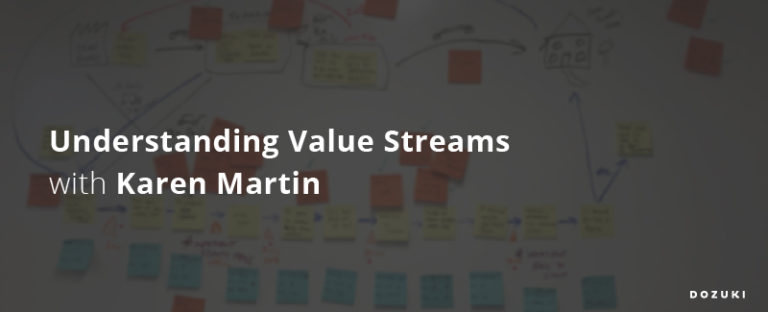
Understanding Value Streams with Karen Martin

Employee on-boarding is often overlooked in the business world. We spoke with Karen Martin, author of "Value Stream Mapping" about why all supportive processes are equally important and how leaders can distinguish between process-level improvements and strategic, value stream improvements.
Dozuki: Your book begins by stating that Value Stream Mapping (VSM) is about developing efficient “customer-centric” processes, however, many companies can overlook core processes that support the main value stream. Can you explain this distinction and how this oversight might happen?
Karen Martin: There are two primary types of value streams: core value streams and supportive value streams. In the strict definition of lean, supportive values streams are non-value adding.
However, this is a mistake.
Supportive value streams are the core of how a company treats its employees, and as a result, how employees treat the customer. These supportive processes are very important, and the most important value stream is the new employee on-boarding process. On-boarding is the employees first experience with an organization, and it can be very clunky.
The Consequences of Poor Employee On-boarding
D: Do you have an example of how organizations struggle with this?
KM: I had a client who went out in the field with new employees starting on day one, without the proper company attire for their entire two week training. Not only did they feel like they didn’t belong, they looked like they didn’t belong, and customers even commented about how they didn’t look like part of the company.
How disrespectful is that? To put someone out there, who is trying to establish relationships with customers and promote the organization, yet they don’t even look like they are a part of it.
All to often companies will be proud of their lean practices, but if you were to ask a new hire about this, they’d probably have a pretty different view.
Key takeaway:
Treat supportive value streams with as much importance as your main value stream. This will signal to employees that all aspects of your organization are respected equally.
Process Mapping vs. Value Stream Mapping
D: As similar lean tools, it seems like there is a lot of confusion in distinguishing process mapping from value stream mapping. Can you explain the key distinctions between the two, both in scope and application?
KM: Value streams are the full cycle of delivering on a customer request. It’s a large set of linked process.
Processes are comprised of the steps and tasks necessary to get work done at a micro level. The value stream is the full set of these interconnected processes.
A Strategic, Leadership-Level Activity
D: At what point should an organization assess their value stream activities?
KM: Value stream analysis and design are strategic level activities to align cross-functional leadership about the path that the organization needs to take. It’s ultimately a leadership level improvement activity.
Many value stream teams have people too low in the organization participating — they don’t have the authority, nor do they have the experience and vision to design the kinds of big, significant improvements that leaders need to decide on before anyone does the actual work.
Key takeaway:
Only involve leaders in the value stream mapping activities with the authority and experience to make significant improvements.
Helicopters and Traffic Jams
D: It seems like the distinction between process maps and value stream maps is more of a spectrum, rather than a hard line. How do you look at the two differently so you don't waste time mapping something that is too granular, or at a process level?
KM: Think of a helicopter hovering over a freeway, it can see where one on-ramp is getting crowded and another off-ramp is empty… you see flow and lack of flow. To everybody that uses value stream mapping, that is the perspective to take—the point is to see at a high level, to understand where the big problems lie. In that way, it becomes a prioritization tool.

KM: Where are we going to focus our energy so that we don’t waste a bunch of time? When we look at it from the process level, it’s like being in a car on the highway, you really can’t see more than a couple cars ahead and a couple cars back, so you don’t know what to do about the entire traffic jam.
Key takeaway:
Improving the overall efficiency of your organization can't be done from a process-level view. Use value streams to provide the perspective and and clarity necessary to drive strategic, cross-departmental improvements.
“It's important to remember that the purpose of maps is to provide clarity and a shared understanding, which then drives meaningful conversations and reaching consensus about necessary improvements. At the end of the day, it's not about the maps. It's about transforming work systems and achieving results. ”
- Karen Martin, Mapping is Situational
 About Karen Martin
About Karen Martin
Karen Martin has been helping companies drive profitability and growth for over 25 years and has authored several industry leading books. Her new book, “Clarity First,” illustrates how eliminating ambiguity is the first step for leaders and organizations to achieve strategic goals.
Read our synopsis of Martin’s “Value Stream Mapping” here.
Related Posts
View All PostsWhy Do Value Stream Mapping? | Benefits & Examples
A successful business incorporates two critical factors, customers, and cost. The goal of any business is to provide the most outstanding value for the customer at the lowest
Continue ReadingBook Club: "Value Stream Mapping" (Part 1)
The Dozuki book club is your go-to place for industry books and resources. Our team curates knowledge from industry experts, letting you identify key takeaways and start...
Continue ReadingBook Club: "Value Stream Mapping" (part 2)
The Dozuki book club is your go-to place for industry books and resources. Our team curates knowledge from industry experts, letting you identify key takeaways and start...
Continue Reading



